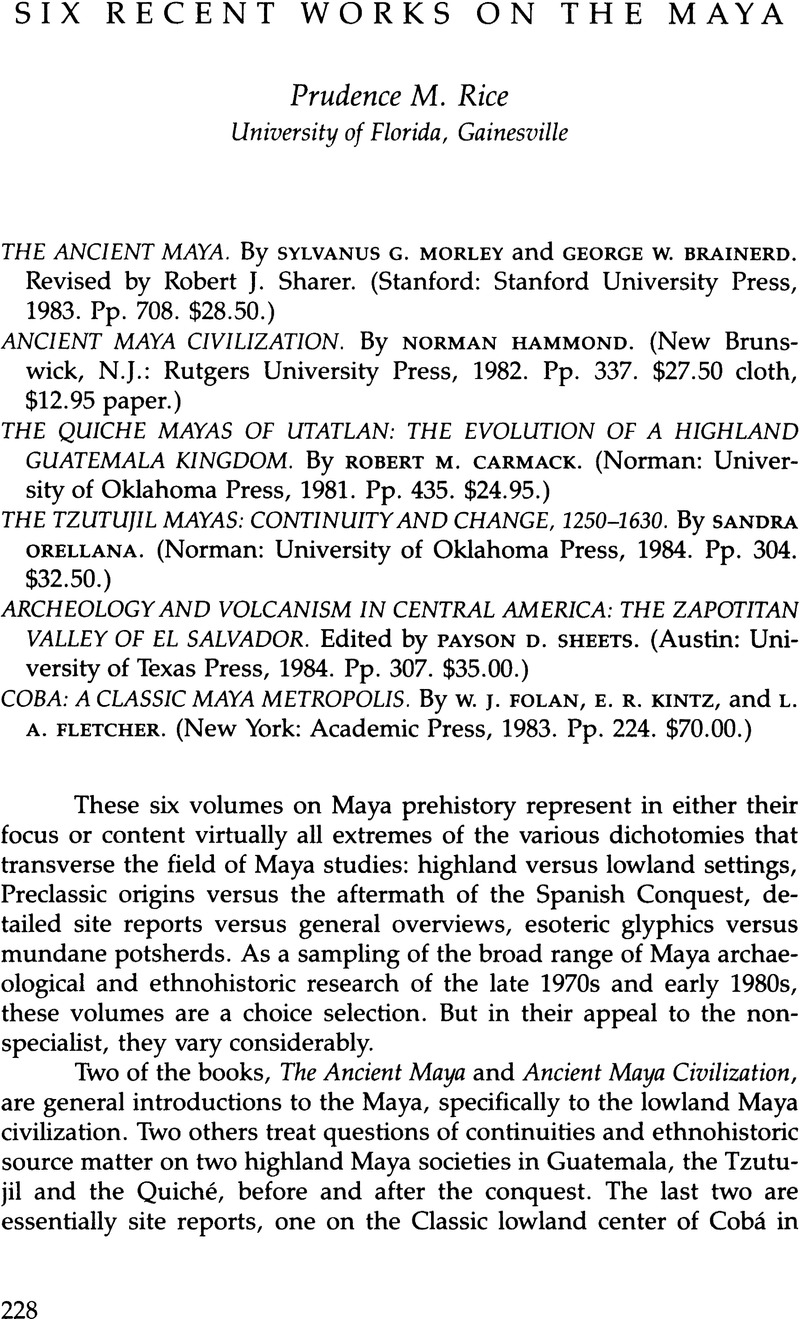No CrossRef data available.
Article contents
Six Recent Works on the Maya
Review products
Published online by Cambridge University Press: 12 October 2022
Abstract

- Type
- Review Essays
- Information
- Copyright
- Copyright © 1986 by the University of Texas Press
References
Notes
1. Other articles summarizing the history of Maya archaeology include N. Hammond, “Lords of the Jungle: A Prosopography of Maya Archaeology,” in Civilization in the Ancient Americas, edited by R. ML Leventhal and A. Kolata (Albuquerque: University of New Mexico Press, 1983), 3–32; also Marshall Joseph Becker, “Priests, Peasants, and Ceremonial Centers: The Intellectual History of a Model,” in Maya Archaeology and Ethnohistory, edited by N. Hammond and G. R. Willey (Austin: University of Texas Press, 1979), 3–20.
2. For example, Morley's Inscriptions of Petén (Washington, D.C.: Carnegie Institution of Washington, 1938–39), based on his explorations in the tropical forests of the Maya lowlands to record inscriptions on carved monuments, was a pioneer publication on the deciphering of the dates on these stelae. A later compendium is J. E. S. Thompson's A Catalog of Maya Hieroglyphs (Norman: University of Oklahoma Press, 1962). For more up-to-date work on epigraphy and the Maya writing system, see L. Scheie, Maya Glyphs: The Verbs (Austin: University of Texas Press, 1982).
3. See the papers in The Lowland Maya Postclassic, edited by A. F. Chase and P. M. Rice (Austin: University of Texas Press, 1985); A. Benavides C. and A. P. Andrews, Arqueología histórica en el área maya (Mexico City: Sociedad Mexicana de Antropología, in press); and Late Lowland Maya Civilization: Classic to Postclassic, edited by E. Wyllys Andrews V and Jeremy A. Sabloff (Albuquerque: University of New Mexico Press, in press).
4. See Annals of the Cakchiquels, trans. from Cakchiquel Maya by A. Recinos and D. Goetz (Norman: University of Oklahoma Press, 1953).
5. L. Ochoa and L. Casasola, “Los cambios del patrón de asentamiento en el área del Usumacinta,” in Estudios preliminares sobre los mayas de las tierras bajas noroccidentales, edited by L. Ochoa (Mexico City: Universidad Nacional Autónoma de México, 1978).
6. The theme of intrusions by Mexicans or Toltecs into the Maya highlands in the Postclassic period, the crux of Carmack's book, is also to be found in J. W. Fox, “Lowland to Highland Mexicanization Processes in Southern Mesoamerica,” American Antiquity 45 (1980):43–54. But other excavations at Utatlán and nearby sites associated with the Quiché confederacy have revealed little solid evidence indicating ties to the Gulf coastal lowlands. See K. L. Brown, “Postclassic Relationships between the Highland and Lowland Maya,” in Chase and Rice, The Lowland Maya Postclassic, 270–81. Another view of these relationships is based on Maya intrusions into the highlands; see D. McVicker, “The ‘Mayanized’ Mexicans,” American Antiquity 50, no. 1 (1985):82–101.
7. For archaeological settlement data and maps of the highland areas discussed in these books, see J. W. Fox, Quiché Conquest: Centralism and Regionalism in Highland Guatemalan State Development (Albuquerque: University of New Mexico Press, 1978); also E. M. Shook, “Archaeological Survey of the Pacific Coast of Guatemala,” in Archaeology of Southern Mesoamerica, vol. 2 of Handbook of Middle American Indians, edited by G. R. Willey (Austin: University of Texas Press, 1965), 180–94.
8. See Shook, “Archaeological Survey.”
9. See, for example, R. Wilk and W. L. Rathje, “Towards an Archaeology of the Household,” American Behavioral Scientist 7 (1982):617–41.
10. See A. P. Andrews and F. Robles C., “Chichén Itzá and Cobá: An Itzá-Maya Standoff in Early Postclassic Yucatán,” in Chase and Rice, The Lowland Maya Postclassic, 62–72.
11. J. Marcus, “Lowland Maya Archaeology at the Crossroads,” American Antiquity 48, no. 3 (1983):454–88.
12. See D. Pendergast, “Recent Research on Maya Lowlands Prehistory,” LARR 19, no. 3 (1984):238; A. P. Andrews, “Long-Distance Exchange among the Maya: A Comment on Marcus,” American Antiquity 49, no. 4 (1984):826–28; N. Hammond, “Two Roads Diverged: A Brief Comment on ‘Lowland Maya Archaeology at the Crossroads’,” American Antiquity 49, no. 4 (1984):821–26.


